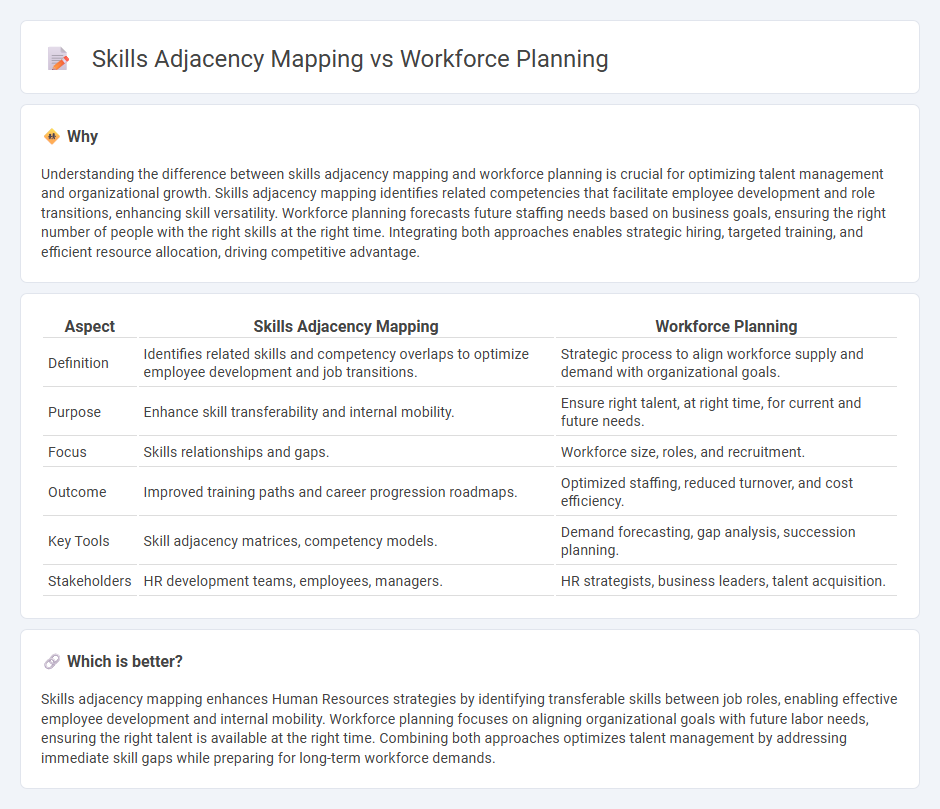
Skills adjacency mapping identifies related competencies to optimize employee development and talent mobility within an organization. Workforce planning forecasts future human capital needs by analyzing current talent capabilities and anticipated business demands. Explore how integrating skills adjacency mapping with workforce planning can enhance strategic HR management.
Why it is important
Understanding the difference between skills adjacency mapping and workforce planning is crucial for optimizing talent management and organizational growth. Skills adjacency mapping identifies related competencies that facilitate employee development and role transitions, enhancing skill versatility. Workforce planning forecasts future staffing needs based on business goals, ensuring the right number of people with the right skills at the right time. Integrating both approaches enables strategic hiring, targeted training, and efficient resource allocation, driving competitive advantage.
Comparison Table
| Aspect | Skills Adjacency Mapping | Workforce Planning |
|---|---|---|
| Definition | Identifies related skills and competency overlaps to optimize employee development and job transitions. | Strategic process to align workforce supply and demand with organizational goals. |
| Purpose | Enhance skill transferability and internal mobility. | Ensure right talent, at right time, for current and future needs. |
| Focus | Skills relationships and gaps. | Workforce size, roles, and recruitment. |
| Outcome | Improved training paths and career progression roadmaps. | Optimized staffing, reduced turnover, and cost efficiency. |
| Key Tools | Skill adjacency matrices, competency models. | Demand forecasting, gap analysis, succession planning. |
| Stakeholders | HR development teams, employees, managers. | HR strategists, business leaders, talent acquisition. |
Which is better?
Skills adjacency mapping enhances Human Resources strategies by identifying transferable skills between job roles, enabling effective employee development and internal mobility. Workforce planning focuses on aligning organizational goals with future labor needs, ensuring the right talent is available at the right time. Combining both approaches optimizes talent management by addressing immediate skill gaps while preparing for long-term workforce demands.
Connection
Skills adjacency mapping enhances workforce planning by identifying related competencies that enable flexible talent allocation and targeted development. This connection supports strategic hiring and internal mobility, ensuring the organization adapts to evolving skill demands efficiently. Integrating these approaches optimizes resource utilization and aligns workforce capabilities with business goals.
Key Terms
Talent forecasting
Workforce planning involves analyzing current talent and predicting future needs to align staff capabilities with organizational goals, while skills adjacency mapping identifies related competencies that facilitate employee development and internal mobility. Talent forecasting leverages both methods to anticipate skill gaps, optimize recruitment, and enhance succession planning by understanding the proximity of skills within the workforce. Explore how integrating workforce planning with skills adjacency mapping can elevate your talent forecasting strategy.
Role competency gaps
Workforce planning identifies role competency gaps by analyzing current employee skills against future organizational needs to ensure optimal talent allocation. Skills adjacency mapping enhances this process by highlighting related skill sets that employees can quickly develop, enabling more agile and effective upskilling strategies. Explore how integrating both methods can streamline closing competency gaps and boost organizational performance.
Upskilling pathways
Workforce planning centers on aligning organizational talent needs with strategic goals by forecasting future workforce requirements and addressing skill gaps. Skills adjacency mapping identifies related competencies that enable employees to transition smoothly into new roles through targeted upskilling, enhancing career mobility and organizational agility. Explore how combining these approaches can optimize talent development and drive effective upskilling pathways.
Source and External Links
What Is Workforce Planning? Strategies and Benefits -- Workforce planning is the process of analyzing an organization's future staffing needs and developing strategies to build a workforce that meets its long-term goals by assessing current capabilities, forecasting future requirements, identifying gaps, creating action plans, and continuously monitoring results.
Workforce Planning: Definition, Process and Principles -- Workforce planning involves determining strategic direction, analyzing current and future talent supply and demand, and aligning employee skills and attributes with business objectives to ensure organizational success.
Workforce Planning - NIH: Office of Human Resources -- Workforce planning is the structured process of analyzing, forecasting, and planning workforce supply and demand, identifying gaps, and implementing targeted interventions to ensure the right people with the right skills are in place to achieve organizational goals.
 dowidth.com
dowidth.com